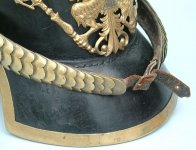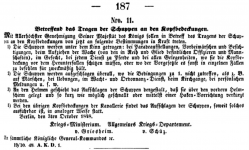Hallo! I have a question re: pickelhaube chin scales. Sorry if I do not use correct terminology, I am new to this field of collecting.
Most chin scales that I see (whether plain brass or gilt brass) have a small knob on one end and a hole on the other. When the leather strap with buckle that is behind the scales isn't being worn under the chin, the strap can be tucked behind the chin scales up on the visor, with the ends of the scales snapped together over the leather strap.
I recently saw chin scales on a pickelhaube though that did NOT have the knob and hole on the ends, which were plain. They were definitely antique. Instead, the leather strap was adjusted resting on the visor so that the buckle showed in a gap between the two ends of the scales. I can't post a photo because I saw this in a shop where taking photos was forbidden.
Is one of these methods for how the scales rest on the visor (snapped together or not) older than the other or were they contiguous in time?
My thanks!
Most chin scales that I see (whether plain brass or gilt brass) have a small knob on one end and a hole on the other. When the leather strap with buckle that is behind the scales isn't being worn under the chin, the strap can be tucked behind the chin scales up on the visor, with the ends of the scales snapped together over the leather strap.
I recently saw chin scales on a pickelhaube though that did NOT have the knob and hole on the ends, which were plain. They were definitely antique. Instead, the leather strap was adjusted resting on the visor so that the buckle showed in a gap between the two ends of the scales. I can't post a photo because I saw this in a shop where taking photos was forbidden.
Is one of these methods for how the scales rest on the visor (snapped together or not) older than the other or were they contiguous in time?
My thanks!


